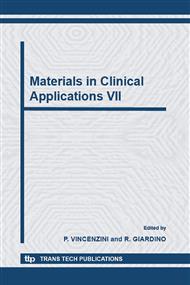p.37
p.45
p.51
p.56
p.62
p.68
p.74
p.79
p.85
Drug Release from Hydroxyapatite Implants with Different Microstructure and Phase Composition
Abstract:
The goal of our studies has been to determine under in vitro conditions the amount and rate of pentoxifylline release from the samples of modified hydroxyapatite [HAp-Ca10(PO4)6(OH)2] implants in the form of microporous blocks (heterogeneous system) as well as from hydroxyapatitegypsum pellets (homogeneous system). For the preparation of microporous hydroxapatite ceramics additives of calcium metaphosphate Ca(PO3)2 (5 and 10 wt. %) or hydrated magnesium orthophosphate Mg3(PO4)2·8H2O (10 wt. %) were used as modifiers. In the case of drug release from heterogeneous carriers, cylinders filled with 50 mg of PTX were used. In the homogeneous system the pellets made of HAp and CaSO4·1/2H2O powders with homogeneously incorporated of 50 mg PTX were applied. It has been shown that the process of drug release from multifunctional ceramic implants depends to a significant degree on the microstructure of the materials, and the type of carrier system (heterogeneous or homogeneous).
Info:
Periodical:
Pages:
62-67
Citation:
Online since:
October 2006
Keywords:
Price:
Сopyright:
© 2006 Trans Tech Publications Ltd. All Rights Reserved
Share:
Citation:


